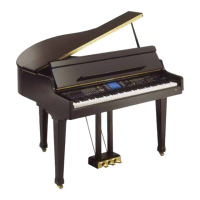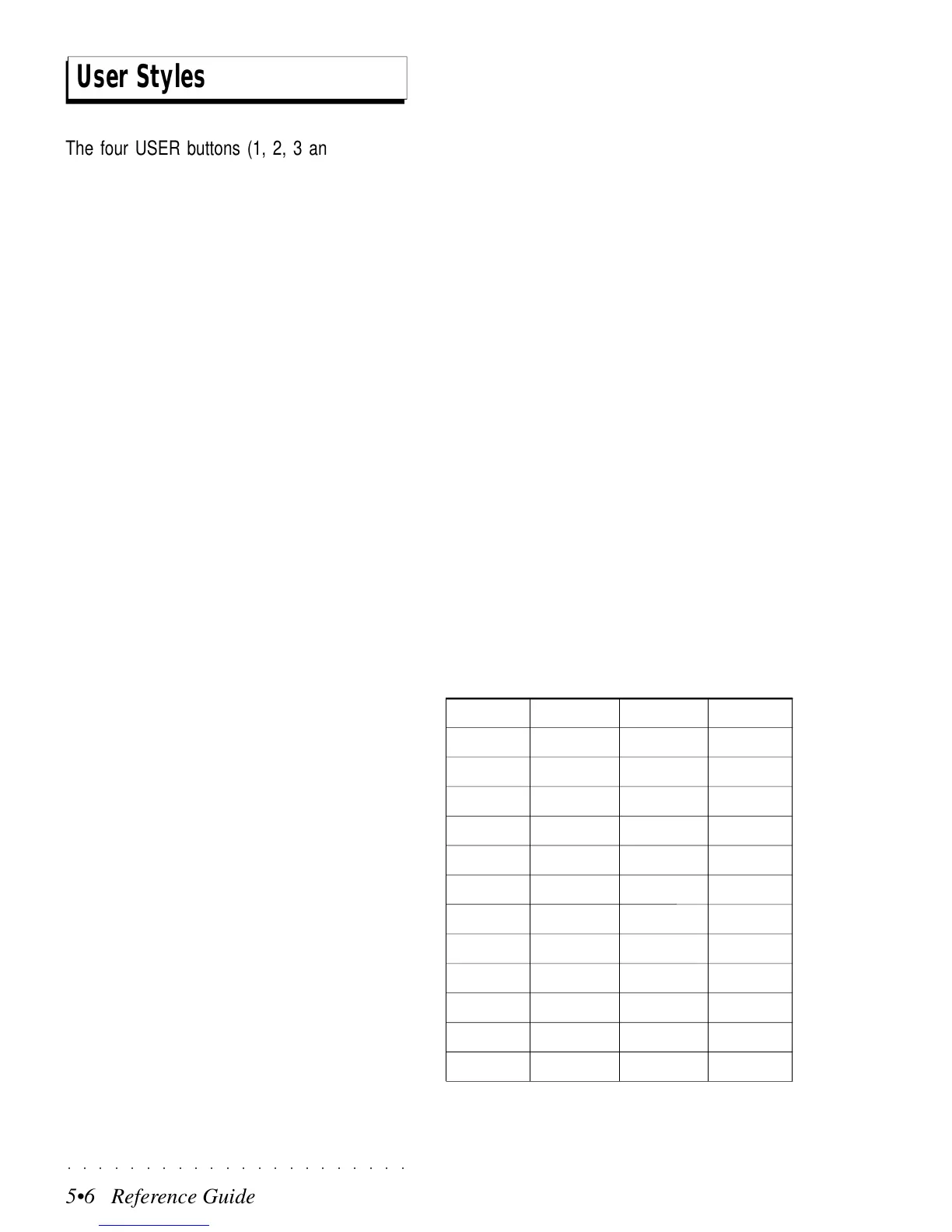○○○○○○○○○○○○○○○○○○○○○○
5•6 Reference Guide
○○○○○○○○○○○○○○○○○○○○○○
5•6 Reference Guide
User Styles
The four USER buttons (1, 2, 3 and 4) of the
STYLE GROUPS section recall User-program-
mable Styles, in other words, free locations that
allow you to record your own auto accompani-
ments. Up to 32 User Styles can reside in
memory, 8 in each User Group.
A new Style can be created by recording every
part yourself. You can also modify an existing
Style. This second option is explained in the Edit
Style section on page 5.14.
Disk based User Styles can be loaded into
memory (to the User 1, 2, 3 and 4 locations) and
user-programmed Styles can be saved to disk,
using the methods described in the Disk chapter
of the Reference Guide, page 4.6.
THE BASIC STRUCTURE OF A STYLE
Styles provide automatic accompaniments based
on the system of chords. In particular, the Major,
Minor and Seventh chords trigger three com-
pletely different arrangement patterns.
There are 4 Variations of the Major, minor and
7th chords and each Variation breaks down into
several different sections: basic, Intro, Fill, End-
ing. These four sections form the basis of a struc-
ture consisting of 48 short sequences, or “Riffs”,
for each Style.
WHAT IS A RIFF?
A Riff is a musical motif capable of repetition (loop-
ing). It can also be expressed as a “phrase” or
“lick”, but it is important to understand that the
Riff must be capable of repetition. In fact, when
you play with Styles, you will note that the pat-
terns are short repeating sequences.
The table shown on this page lists all the Riffs
that make up a Style.
The basic Riff is the principal pattern of the Style
which repeats continually until stopped, or until it
is “broken” by a Fill, Intro or Ending pattern.
The Fills, Intros and Endings are triggered by
pressing the relative FILL, INTRO, or ENDING
buttons.
A Riff can vary in length from one to sixteen meas-
ures long.
Each Riff consists of up to 8 Style tracks: Drum,
Bass, Acc1, Acc2, Acc3, Acc4, Acc5, Acc6.
Var1 Var2 Var3 Var4
Basic Major Basic Major Basic Major Basic Major
Basic Minor Basic Minor Basic Minor Basic Minor
Basic 7th Basic 7th Basic 7th Basic 7th
Fill Major Fill Major Fill Major Fill Major
Fill Minor Fill Minor Fill Minor Fill Minor
Fill 7th Fill 7th Fill 7th Fill 7th
Intro Major Intro Major Intro Major Intro Major
Intro Minor Intro Minor Intro Minor Intro Minor
Intro 7th Intro 7th Intro 7th Intro 7th
End Major End Major End Major End Major
End Minor End Minor End Minor End Minor
End 7th End 7th End 7th End 7th
Riffs of a Style
User Styles
The four USER buttons (1, 2, 3 and 4) of the
STYLE GROUPS section recall User-program-
mable Styles, in other words, free locations that
allow you to record your own auto accompani-
ments. Up to 32 User Styles can reside in
memory, 8 in each User Group.
A new Style can be created by recording every
part yourself. You can also modify an existing
Style. This second option is explained in the Edit
Style section on page 5.14.
Disk based User Styles can be loaded into
memory (to the User 1, 2, 3 and 4 locations) and
user-programmed Styles can be saved to disk,
using the methods described in the Disk chapter
of the Reference Guide, page 4.6.
THE BASIC STRUCTURE OF A STYLE
Styles provide automatic accompaniments based
on the system of chords. In particular, the Major,
Minor and Seventh chords trigger three com-
pletely different arrangement patterns.
There are 4 Variations of the Major, minor and
7th chords and each Variation breaks down into
several different sections: basic, Intro, Fill, End-
ing. These four sections form the basis of a struc-
ture consisting of 48 short sequences, or “Riffs”,
for each Style.
WHAT IS A RIFF?
A Riff is a musical motif capable of repetition (loop-
ing). It can also be expressed as a “phrase” or
“lick”, but it is important to understand that the
Riff must be capable of repetition. In fact, when
you play with Styles, you will note that the pat-
terns are short repeating sequences.
The table shown on this page lists all the Riffs
that make up a Style.
The basic Riff is the principal pattern of the Style
which repeats continually until stopped, or until it
is “broken” by a Fill, Intro or Ending pattern.
The Fills, Intros and Endings are triggered by
pressing the relative FILL, INTRO, or ENDING
buttons.
A Riff can vary in length from one to sixteen meas-
ures long.
Each Riff consists of up to 8 Style tracks: Drum,
Bass, Acc1, Acc2, Acc3, Acc4, Acc5, Acc6.
Var1 Var2 Var3 Var4
Basic Major Basic Major Basic Major Basic Major
Basic Minor Basic Minor Basic Minor Basic Minor
Basic 7th Basic 7th Basic 7th Basic 7th
Fill Major Fill Major Fill Major Fill Major
Fill Minor Fill Minor Fill Minor Fill Minor
Fill 7th Fill 7th Fill 7th Fill 7th
Intro Major Intro Major Intro Major Intro Major
Intro Minor Intro Minor Intro Minor Intro Minor
Intro 7th Intro 7th Intro 7th Intro 7th
End Major End Major End Major End Major
End Minor End Minor End Minor End Minor
End 7th End 7th End 7th End 7th
Riffs of a Style
○○○○○○○○○○○○○○○○○○○○○○
5•6 Reference Guide
○○○○○○○○○○○○○○○○○○○○○○
5•6 Reference Guide
User Styles
The four USER buttons (1, 2, 3 and 4) of the
STYLE GROUPS section recall User-program-
mable Styles, in other words, free locations that
allow you to record your own auto accompani-
ments. Up to 32 User Styles can reside in
memory, 8 in each User Group.
A new Style can be created by recording every
part yourself. You can also modify an existing
Style. This second option is explained in the Edit
Style section on page 5.14.
Disk based User Styles can be loaded into
memory (to the User 1, 2, 3 and 4 locations) and
user-programmed Styles can be saved to disk,
using the methods described in the Disk chapter
of the Reference Guide, page 4.6.
THE BASIC STRUCTURE OF A STYLE
Styles provide automatic accompaniments based
on the system of chords. In particular, the Major,
Minor and Seventh chords trigger three com-
pletely different arrangement patterns.
There are 4 Variations of the Major, minor and
7th chords and each Variation breaks down into
several different sections: basic, Intro, Fill, End-
ing. These four sections form the basis of a struc-
ture consisting of 48 short sequences, or “Riffs”,
for each Style.
WHAT IS A RIFF?
A Riff is a musical motif capable of repetition (loop-
ing). It can also be expressed as a “phrase” or
“lick”, but it is important to understand that the
Riff must be capable of repetition. In fact, when
you play with Styles, you will note that the pat-
terns are short repeating sequences.
The table shown on this page lists all the Riffs
that make up a Style.
The basic Riff is the principal pattern of the Style
which repeats continually until stopped, or until it
is “broken” by a Fill, Intro or Ending pattern.
The Fills, Intros and Endings are triggered by
pressing the relative FILL, INTRO, or ENDING
buttons.
A Riff can vary in length from one to sixteen meas-
ures long.
Each Riff consists of up to 8 Style tracks: Drum,
Bass, Acc1, Acc2, Acc3, Acc4, Acc5, Acc6.
Var1 Var2 Var3 Var4
Basic Major Basic Major Basic Major Basic Major
Basic Minor Basic Minor Basic Minor Basic Minor
Basic 7th Basic 7th Basic 7th Basic 7th
Fill Major Fill Major Fill Major Fill Major
Fill Minor Fill Minor Fill Minor Fill Minor
Fill 7th Fill 7th Fill 7th Fill 7th
Intro Major Intro Major Intro Major Intro Major
Intro Minor Intro Minor Intro Minor Intro Minor
Intro 7th Intro 7th Intro 7th Intro 7th
End Major End Major End Major End Major
End Minor End Minor End Minor End Minor
End 7th End 7th End 7th End 7th
Riffs of a Style
User Styles
The four USER buttons (1, 2, 3 and 4) of the
STYLE GROUPS section recall User-program-
mable Styles, in other words, free locations that
allow you to record your own auto accompani-
ments. Up to 32 User Styles can reside in
memory, 8 in each User Group.
A new Style can be created by recording every
part yourself. You can also modify an existing
Style. This second option is explained in the Edit
Style section on page 5.14.
Disk based User Styles can be loaded into
memory (to the User 1, 2, 3 and 4 locations) and
user-programmed Styles can be saved to disk,
using the methods described in the Disk chapter
of the Reference Guide, page 4.6.
THE BASIC STRUCTURE OF A STYLE
Styles provide automatic accompaniments based
on the system of chords. In particular, the Major,
Minor and Seventh chords trigger three com-
pletely different arrangement patterns.
There are 4 Variations of the Major, minor and
7th chords and each Variation breaks down into
several different sections: basic, Intro, Fill, End-
ing. These four sections form the basis of a struc-
ture consisting of 48 short sequences, or “Riffs”,
for each Style.
WHAT IS A RIFF?
A Riff is a musical motif capable of repetition (loop-
ing). It can also be expressed as a “phrase” or
“lick”, but it is important to understand that the
Riff must be capable of repetition. In fact, when
you play with Styles, you will note that the pat-
terns are short repeating sequences.
The table shown on this page lists all the Riffs
that make up a Style.
The basic Riff is the principal pattern of the Style
which repeats continually until stopped, or until it
is “broken” by a Fill, Intro or Ending pattern.
The Fills, Intros and Endings are triggered by
pressing the relative FILL, INTRO, or ENDING
buttons.
A Riff can vary in length from one to sixteen meas-
ures long.
Each Riff consists of up to 8 Style tracks: Drum,
Bass, Acc1, Acc2, Acc3, Acc4, Acc5, Acc6.
Var1 Var2 Var3 Var4
Basic Major Basic Major Basic Major Basic Major
Basic Minor Basic Minor Basic Minor Basic Minor
Basic 7th Basic 7th Basic 7th Basic 7th
Fill Major Fill Major Fill Major Fill Major
Fill Minor Fill Minor Fill Minor Fill Minor
Fill 7th Fill 7th Fill 7th Fill 7th
Intro Major Intro Major Intro Major Intro Major
Intro Minor Intro Minor Intro Minor Intro Minor
Intro 7th Intro 7th Intro 7th Intro 7th
End Major End Major End Major End Major
End Minor End Minor End Minor End Minor
End 7th End 7th End 7th End 7th
Riffs of a Style

